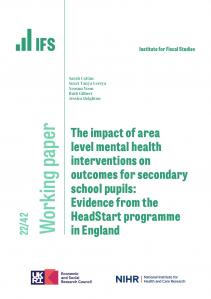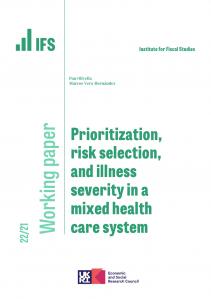This observation provides an assessment of the SNP’s Sustainable Growth Commission’s proposals. Commendably, rather than duck the issue, they set out how they would approach the challenging public finance position an independent Scotland would start life with. Their proposals imply another decade of the sort of restraint on public spending that Scotland is currently experiencing. If this is austerity, then austerity would be extended under the Commission’s proposals.
Today, politicians and policy wonks are gathering at the Royal Society of Edinburgh to discuss the outlook for Scotland’s public finances over the next five years and beyond. Attendees will discuss how Scotland can best adapt to continuing reductions in block grant funding from Westminster and downgraded tax revenue forecasts over the next few years as well as meet longer-term public finance challenges such as those arising from an ageing population and weak productivity growth.
Last month, the SNP’s Sustainable Growth Commission published proposals for how an independent Scotland could tackle these sorts of issues. Commendably, rather than duck the issue, the Commission accepted that the public finance picture would be even more challenging in the first decade of independence – and set out a plan to significantly reduce the budget deficit an independent Scotland would likely start life with.
This observation looks at these plans. It finds that they imply at least another decade of the sort of restraint on public spending that Scotland is currently experiencing. If current policy is austerity, then austerity would continue under the Commission’s proposals. It asks whether there are alternatives, or whether an independent Scotland would have to go even further to fix its public finances. And it discusses the role of economic growth in these questions.
What does the Commission say about a newly independent Scotland’s finances?
The Commission bases its proposals on the public finance numbers for Scotland set out in the official Government Expenditure and Revenue Scotland (GERS) publication. This is a sensible place to start.
The most recent figures (2016–17) imply a budget deficit for Scotland of 8.3% of GDP. Managing this is the UK Government’s responsibility as it is part of the UK’s deficit, which was 2.3% of UK-wide GDP in the same year. Therefore there was a fiscal transfer from the rest of the UK to Scotland of about 6% of Scotland’s GDP (equivalent to around £1,750 per person in Scotland).
To produce an illustrative starting point for an independent Scotland in 2021–22, the Commission uses Office for Budget Responsibility (OBR) forecasts for total public sector expenditure and revenues. This is a more sensible and cautious approach than that taken by the Scottish Government in 2013 who used figures for oil revenues that far exceeded OBR forecasts, and to date, have been proven wildly over-optimistic. The new forecasts give a projected Scottish deficit of 7.1% of GDP in 2021–22.
The Commission then knocks off forecast oil revenues, saying that these should be stewarded for the long-term benefit of Scotland. There is merit in doing this, as after all, oil is a finite resource. The deficit excluding oil revenues would be 7.5% of GDP.
Finally they reduce the forecast deficit to take account of savings they say can be made to Scotland’s current contribution to the UK’s debt interest bill (0.4% of GDP) and defence and other UK government spending (0.7% of GDP), as well as to account for additional tax revenues from UK government jobs and spending transferring to Scotland (0.5%). That gives an adjusted deficit for year one of independence of 5.9% of GDP.
One can quibble with these numbers. Perhaps Scotland would have to contribute not only to the debt interest bill, but also pay off its share of the underlying debt? Is it sensible to bank on savings when Scotland could also lose out on the economies of scale enjoyed at the UK level? And would the government jobs transferring to Scotland translate in full into higher employment and tax revenues or could they attract workers from other jobs? Nevertheless, given the difficulties of public finance forecasting, the Commission’s projections are not implausible.
What are the Commission’s proposals for subsequent years?
To reduce the 5.9% deficit, the Commission proposes that total public expenditure (excluding debt interest) should increase by 1% less per year than GDP for the first decade of independence. With assumed real GDP growth of 1.5% a year, that means holding down real growth in spending on public services and benefits to 0.5% a year.
Such an approach would see spending on public services and benefits fall by about 4% of GDP over that decade. Add on the growing amount the Scottish government would have to spend on servicing its increasing post-independence debt, and overall public spending and hence the deficit would fall by 3% of GDP. Together with some assumed but unspecified efficiency savings (0.3% of GDP), that brings the forecast deficit down to 2.6% of GDP one decade after Scottish independence.
Figure 1. Sustainable Growth Commission’s projections for the Scottish deficit under its plans
Are the proposals a blueprint for further austerity?
The Commission claims their proposals do not amount to austerity as public spending would be increasing in real terms. But their plans would mean spending on public services and benefits falling by 4% of GDP over the course of a decade. That’s on top of the reductions delivered and planned by the UK government for the decade from 2010 to 2020, and the Commission’s proposals for immediate cuts to defence and other spending currently undertaken by the UK government. The ageing of the population – which adds to pressures on the health, social care and state pension budgets – means that keeping to an overall spending increase of just 0.5% a year would likely require cuts to many other public services. Unsurprisingly, the Commission does not say where the axe would fall.
It is also inconsistent to claim that these plans do not amount to austerity but the UK government’s current policy does. While the UK government did reduce total public spending by an average of 0.2% a year in real-terms between 2009–10 and 2016–17, since then, it has eased off somewhat. Between 2016–17 and 2022–23, total public spending excluding debt interest payments is forecast to grow by an average of 0.7% a year in real-terms. The Commission’s proposals for 0.5% increases per year therefore look remarkably like an extension of current policy in the UK: indeed they imply slightly slower real growth in spending than the UK Government is currently implementing.
Table 1. Real terms spending and GDP changes
Could austerity be avoided?
It’s difficult to see how a newly independent Scotland could avoid the sort of deficit reduction programme set out by the Sustainable Growth Commission. It should be commended for setting out how they would approach this issue head on, rather than ignoring it, or resorting to over-optimistic forecasts on revenues from the North Sea, for instance, to massage down the scale of the problem.
An annual budget deficit of 5.9% of GDP would simply not be sustainable on an ongoing basis. One can debate the timing of the reduction – perhaps delaying a couple of years, or going a little slower. One could choose to make some of the adjustment by increasing taxes rather than just holding down spending. But such a large deficit would need to be tackled to avoid ballooning debt and interest payments and a loss of confidence and credibility, which would be particularly damaging to a newly independent small country.
In fact, a case could be made for going further and/or faster. A deficit of almost 2.6% of GDP might be sustainable for a large country with good growth and a long track record of borrowing on international markets. For a new and relatively small country it may not. The Commission rightly highlights how smaller countries typically run smaller deficits or even surpluses: seven of the twelve small developed countries cited in the Commission’s report ran budget surpluses in 2016. Completely eliminating Scotland’s forecast deficit over 10 years would require real-terms cuts to spending of around 0.2% a year. Or it would take around 8 more years of holding down spending growth to 0.5% a year, on top of the 10 years envisioned by the Commission. In other words, even further austerity.
What about growth?
That is, if growth remained at 1.5% a year.
Stronger economic growth would not only boost living standards, it could ease the public finance challenge. Put simply, it would mean bigger increases in tax revenues, allowing an independent Scotland to repair its public finances without such a large and sustained squeeze on public spending.
But how could an independent Scotland boost growth?
The Commission claims that the UK’s decision to leave the EU will hurt the economy – something the vast majority of economists would agree with. The implication is that rejoining the EU as an independent country could allow Scotland to avoid this hit, boosting growth.
The main reason economists expect an economic hit from leaving the EU is the bigger trade barriers that will exist, especially if the UK is outside the EU’s single market and customs union. But if Scotland left the UK and rejoined the EU that could instead mean additional trade barriers between Scotland and the rest of the UK, with which Scotland currently trades four times as much with as with the EU. The Commission’s figures make no allowance for any negative economic impact from such barriers. They could quite easily outweigh the gains from rejoining the EU.
More promisingly, the Commission emphasises the role that increasing productivity, labour force participation and the size of the working-age population could all play in boosting economic growth. It makes sensible suggestions in a number of areas, not least in relation to the role immigration can play in counterbalancing an ageing population.
Such suggestions, when combined with a sober assessment of the weak fiscal position a newly independent Scotland would likely face, and plans for a decade of cuts to public spending as a proportion of GDP to tackle this, make the Commission’s report an important contribution to the debate.









